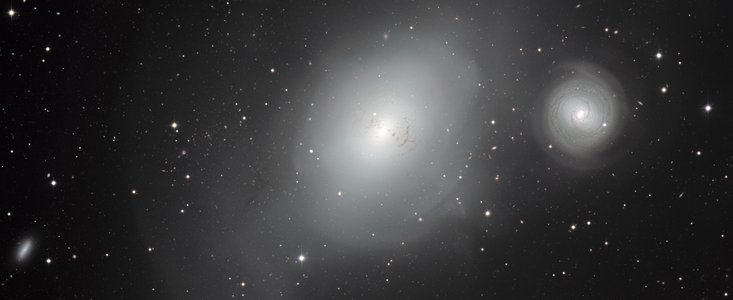Persbericht
Galactische seriemoordenaar
2 april 2014
Deze nieuwe opname van de 2,2-meter MPG/ESO-telescoop van de ESO-sterrenwacht op La Silla (Chili) toont twee contrasterende sterrenstelsels: NGC 1316 en zijn kleinere buur NGC 1317. De ruimtelijke afstand tussen deze stelsels is best klein, maar hun geschiedenissen verschillen sterk. Het kleine spiraalstelsel NGC 1317 heeft een saai leven gehad, maar NGC 1316 heeft in zijn tumultueuze verleden diverse andere stelsels opgeslokt en vertoont daar nog de sporen van.
Uit verschillende kenmerken van NGC 1316 blijkt dat dit stelsel een turbulente voorgeschiedenis heeft. Zo vertoont het enkele ongewone stofbanden [1] die zijn ingebed in een omvangrijk omhulsel van sterren, en een populatie van opvallend kleine bolvormige sterrenhopen. Een en ander wijst erop dat het stelsel ongeveer drie miljard jaar geleden een stofrijk spiraalstelsel heeft opgeslokt.
Ook vertoont NGC 1316 een aantal zeer zwakke getijstaarten – slierten sterren die van hun oorspronkelijke locaties zijn weggerukt en de intergalactische ruimte in zijn geslingerd. Deze structuren zijn veroorzaakt door complexe gravitationele effecten op de banen van de sterren die optreden als een ander sterrenstelsel te dichtbij komt. Al deze sporen wijzen op een onstuimig verleden waarin NGC 1316 andere stelsels heeft geannexeerd, en doen vermoeden dat er nog geen einde is gekomen aan dit verwoestende gedrag.
NGC 1316 staat op ongeveer 60 miljoen lichtjaar van de aarde in het zuidelijke sterrenbeeld Fornax (Oven). Het wordt ook wel Fornax A genoemd – een aanduiding die aangeeft dat dit de helderste bron van radiostraling in dit sterrenbeeld is. NGC 1316 is zelfs de op drie na helderste radiobron aan de hemel [2]. Deze radiostraling wordt opgewekt door materie die naar het superzware zwarte gat in het stelsel toe valt en is door de interacties met andere sterrenstelsels waarschijnlijk van extra brandstof voorzien.
De zeer detailrijke nieuwe opname van de 2,2-meter MPG/ESO-telescoop van de ESO-sterrenwacht op La Silla (Chili) is opgebouwd uit vele afzonderlijke opnamen in het ESO-archief. Het doel van de oorspronkelijke waarnemingen was om de zwakste structuren van NGC 1316 te onthullen en de ontwrichting van dit interessante stelsel te onderzoeken.
Als toegift biedt de nieuwe foto ook een kijkje in het heelal ver achter de twee heldere stelsels op de voorgrond. De meeste vage vlekjes op de foto zijn veel verder weg gelegen sterrenstelsels. Links van NGC 1316 is een opvallende opeenhoping van deze stelsels te zien.
Noten
[1] Deze stofbanden zijn gedetailleerd in beeld gebracht met de Hubble-ruimtetelescoop van NASA en ESA.
[2] Dit geldt voor een radiofrequentie van 1400 MHz; op andere frequenties zal de volgorde anders zijn.
Meer informatie
ESO is de belangrijkste intergouvernementele astronomische organisatie in Europa en de meest productieve sterrenwacht ter wereld. Zij wordt ondersteund door vijftien landen: België, Brazilië, Denemarken, Duitsland, Finland, Frankrijk, Italië, Nederland, Oostenrijk, Portugal, Spanje, Tsjechië, het Verenigd Koninkrijk, Zweden en Zwitserland. ESO voert een ambitieus programma uit, gericht op het ontwerpen, bouwen en beheren van grote sterrenwachten die astronomen in staat stellen om belangrijke wetenschappelijke ontdekkingen te doen. Ook speelt ESO een leidende rol bij het bevorderen en organiseren van samenwerking op astronomisch gebied. ESO beheert drie waarnemingslocaties van wereldklasse in Chili: La Silla, Paranal en Chajnantor. Op Paranal staan ESO’s Very Large Telescope (VLT), de meest geavanceerde optische sterrenwacht ter wereld, en twee surveytelescopen: VISTA werkt in het infrarood en is de grootste surveytelescoop ter wereld en de VLT Survey Telescope is de grootste telescoop die uitsluitend is ontworpen om de hemel in zichtbaar licht in kaart te brengen. ESO is ook de Europese partner van de revolutionaire telescoop ALMA, het grootste astronomische project van dit moment. Daarnaast bereidt ESO momenteel de bouw voor van de 39-meter Europese Extremely Large optical/near-infrared Telescope (E-ELT), die ‘het grootste oog op de hemel’ ter wereld zal worden.
Links
- Foto’s van de 2,2-meter MPG/ESO-telescoop
- Foto’s gemaakt met de 2,2-meter MPG/ESO-telescoop
- Foto’s van La Silla
Contact
Richard Hook
ESO, Public Information Officer
Garching bei München, Germany
Tel: +49 89 3200 6655
Mobiel: +49 151 1537 3591
E-mail: rhook@eso.org
Marieke Baan (Perscontact Nederland)
ESO Science Outreach Network
en NOVA Informatie Centrum
Tel: +31(0)20-5257480
E-mail: eson-netherlands@eso.org
Over dit bericht
| Persberichten nr.: | eso1411nl |
| Naam: | NGC 1316 |
| Type: | Local Universe : Galaxy : Grouping : Pair |
| Facility: | MPG/ESO 2.2-metre telescope |
| Instruments: | WFI |
Our use of Cookies
We use cookies that are essential for accessing our websites and using our services. We also use cookies to analyse, measure and improve our websites’ performance, to enable content sharing via social media and to display media content hosted on third-party platforms.
ESO Cookies Policy
The European Organisation for Astronomical Research in the Southern Hemisphere (ESO) is the pre-eminent intergovernmental science and technology organisation in astronomy. It carries out an ambitious programme focused on the design, construction and operation of powerful ground-based observing facilities for astronomy.
This Cookies Policy is intended to provide clarity by outlining the cookies used on the ESO public websites, their functions, the options you have for controlling them, and the ways you can contact us for additional details.
What are cookies?
Cookies are small pieces of data stored on your device by websites you visit. They serve various purposes, such as remembering login credentials and preferences and enhance your browsing experience.
Categories of cookies we use
Essential cookies (always active): These cookies are strictly necessary for the proper functioning of our website. Without these cookies, the website cannot operate correctly, and certain services, such as logging in or accessing secure areas, may not be available; because they are essential for the website’s operation, they cannot be disabled.
Functional Cookies: These cookies enhance your browsing experience by enabling additional features and personalization, such as remembering your preferences and settings. While not strictly necessary for the website to function, they improve usability and convenience; these cookies are only placed if you provide your consent.
Analytics cookies: These cookies collect information about how visitors interact with our website, such as which pages are visited most often and how users navigate the site. This data helps us improve website performance, optimize content, and enhance the user experience; these cookies are only placed if you provide your consent. We use the following analytics cookies.
Matomo Cookies:
This website uses Matomo (formerly Piwik), an open source software which enables the statistical analysis of website visits. Matomo uses cookies (text files) which are saved on your computer and which allow us to analyze how you use our website. The website user information generated by the cookies will only be saved on the servers of our IT Department. We use this information to analyze www.eso.org visits and to prepare reports on website activities. These data will not be disclosed to third parties.
On behalf of ESO, Matomo will use this information for the purpose of evaluating your use of the website, compiling reports on website activity and providing other services relating to website activity and internet usage.
Matomo cookies settings:
Additional Third-party cookies on ESO websites: some of our pages display content from external providers, e.g. YouTube.
Such third-party services are outside of ESO control and may, at any time, change their terms of service, use of cookies, etc.
YouTube: Some videos on the ESO website are embedded from ESO’s official YouTube channel. We have enabled YouTube’s privacy-enhanced mode, meaning that no cookies are set unless the user actively clicks on the video to play it. Additionally, in this mode, YouTube does not store any personally identifiable cookie data for embedded video playbacks. For more details, please refer to YouTube’s embedding videos information page.
Cookies can also be classified based on the following elements.
Regarding the domain, there are:
- First-party cookies, set by the website you are currently visiting. They are stored by the same domain that you are browsing and are used to enhance your experience on that site;
- Third-party cookies, set by a domain other than the one you are currently visiting.
As for their duration, cookies can be:
- Browser-session cookies, which are deleted when the user closes the browser;
- Stored cookies, which stay on the user's device for a predetermined period of time.
How to manage cookies
Cookie settings: You can modify your cookie choices for the ESO webpages at any time by clicking on the link Cookie settings at the bottom of any page.
In your browser: If you wish to delete cookies or instruct your browser to delete or block cookies by default, please visit the help pages of your browser:
Please be aware that if you delete or decline cookies, certain functionalities of our website may be not be available and your browsing experience may be affected.
You can set most browsers to prevent any cookies being placed on your device, but you may then have to manually adjust some preferences every time you visit a site/page. And some services and functionalities may not work properly at all (e.g. profile logging-in, shop check out).
Updates to the ESO Cookies Policy
The ESO Cookies Policy may be subject to future updates, which will be made available on this page.
Additional information
For any queries related to cookies, please contact: pdprATesoDOTorg.
As ESO public webpages are managed by our Department of Communication, your questions will be dealt with the support of the said Department.






